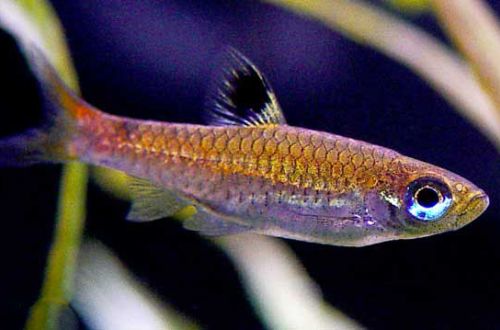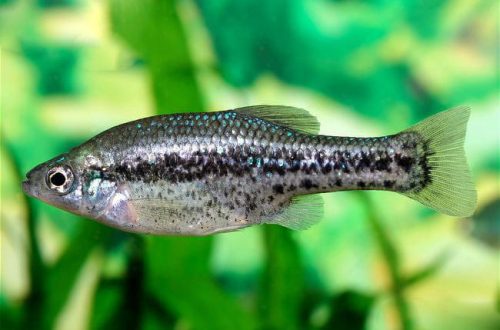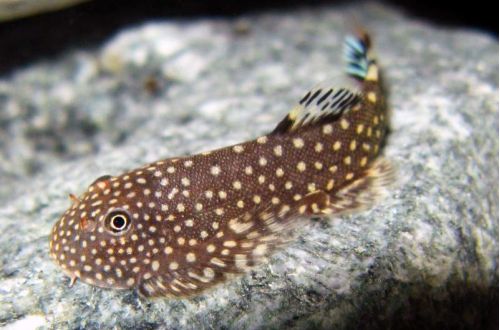
Rasbora spotted dorsal
Spotted rasbora, scientific name Brevibora dorsiocellata, belongs to the Cyprinidae family. A popular tropical fish that has been bred for many generations in the artificial environment of commercial aquariums, therefore it does not require acclimatization and is considered quite simple and not whimsical to keep at home.

Contents
Habitat
It comes from Southeast Asia – the Malay Peninsula, the islands of Borneo and Sumatra. It lives in small rivers and streams flowing under the canopy of tropical forests and originating in ancient peat bogs. The water has a rich brown hue due to the large amount of dissolved tannins and other organic substances, the source of which are numerous fallen leaves, roots and branches of trees, as well as other aquatic vegetation.
Currently, the habitat is on the verge of destruction as a result of human activities.
Brief information:
- The volume of the aquarium – from 40 liters.
- Temperature – 20-25°C
- Value pH — 5.0–7.5
- Water hardness – soft (1-10dGH)
- Substrate type – any
- Lighting – subdued
- Brackish water – no
- Water movement – minimum
- The size of the fish is up to 3.5 cm.
- Food – any food
- Temperament – peaceful
- Keeping in a flock of 8-10 individuals
Description
A miniature fish, in the adult state it reaches only 3.5 cm. Sexual dimorphism is weakly expressed, males differ in somewhat smaller sizes and a reddish tinge of the base of the tail, while in females it is yellow. The main color is gray with translucent fins, a characteristic feature is a white dorsal fin with a large black spot.
Food
Accepts all types of dry, frozen and live foods of suitable size. It is recommended to serve different types of food, which helps to keep the fish in good shape. Feed 2-3 times a day in the amount eaten in 5 minutes.
Maintenance and care, arrangement of the aquarium
The minimum dimensions of the tank do not start from 40 liters. The design uses a soft sandy substrate, shelters in the form of snags, branches or tree roots, rooted and floating plants. The latter provide additional shading to the aquarium, which is very useful, since Rasbora spotted back prefers subdued lighting. It is recommended to use cloth bags filled with natural peat (purchase exclusively at the pet store), or a filter system that uses peat-based filter media. With the help of it, optimal water conditions are achieved, characteristic of the natural habitat – tropical swamps. The water takes on a brown tint, and the pH value is set to slightly acidic values under the condition of low hardness. For more information on pH and dGH, see the “Hydrochemical composition of water” section.
The set of equipment, in addition to the filter, includes a lighting system, a heater and an aerator. Maintenance of the aquarium is reduced to a weekly replacement of part of the water (15–20% of the volume) with fresh and regular cleaning of the soil from organic waste.
Behavior and Compatibility
Peaceful and friendly appearance. Keeping at least 8-10 individuals in a flock will allow such small fish to feel safe. Being in a group, males are forced to compete with each other for the attention of females, and since aggression is not their path, they choose to increase the brightness of their color. Therefore, when kept alone or in the absence of other males, Rasbora becomes lethargic and faded. Compatible with most other calm species of similar temperament and size. In nature, it lives along with such popular aquarium fish as the Five-banded barb, Brilliant Rasbora. It is worth remembering that any large fish can pose a threat.
Breeding / breeding
Refers to spawning species, females scatter eggs in the water column, and males at this moment fertilize it. Parental instincts are poorly developed, immediately after spawning, the fish can eat their own caviar and fry that have appeared. Able to breed throughout the year without much attention from the aquarist, however, due to the above reasons, the survival rate will be at a very low level.
In order to increase the chances and protect juveniles from adult fish, it is recommended to breed in a separate tank – a spawning aquarium. The design is simple, the main attention is paid to the ground, it should consist of particles of a sufficiently large size that do not fit tightly to each other, forming voids, for example, pebbles or decorative glass beads. When the eggs sink to the bottom, most of them fall into these voids and thus become inaccessible to fish. A similar effect is also achieved when using a fine mesh, which is fixed at the bottom.
Another way to ensure the preservation of eggs is to use low-growing small-leaved plants or mosses such as Riccia floating and Javanese moss, which are planted on most of the surface of the substrate (in this case, the soil can be any). Dense thickets of plants can provide reliable shelter for eggs no worse than special soil.
The size of the spawning aquarium for this species is usually about 20 liters, half filled. The equipment used is an aerator, a heater and a simple sponge airlift filter of low power to prevent accidental suction of eggs and fry. Spawning occurs in dim light, so at first there is no need for a light source.
The beginning of the mating season will be marked by the fact that the females become noticeably rounder, and the males will begin to actively show signs of attention to their chosen ones. At this point, you should prepare a separate tank and fill it with water from the general aquarium, then transplant several females and the most colorful males there. Spawning can be initiated by adding cool water, lowering the temperature by a few degrees. If you do this in the evening, then by morning it will be possible to get offspring. The easiest way to determine the end of spawning is by females – they will become noticeably slimmer.
The fish are returned. The fry will appear in 18-48 hours, and after another 1-2 days they will begin to swim freely. Feed with specialized microscopic food for juvenile aquarium fish.
Fish diseases
A balanced diet and suitable living conditions are the best guarantee against the occurrence of diseases in freshwater fish, so if the first symptoms of an illness appear (discoloration, behavior), the first thing to do is check the condition and quality of the water, if necessary, return all values to normal, and only then do treatment. Read more about symptoms and treatments in the Aquarium Fish Diseases section.





